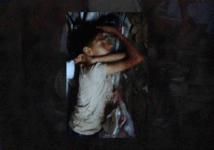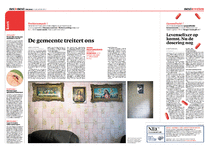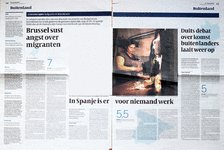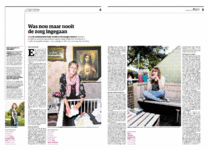User:Luisa Moura/writing/graduation/proposal draft: Difference between revisions
Luisa Moura (talk | contribs) No edit summary |
Luisa Moura (talk | contribs) No edit summary |
||
| Line 1: | Line 1: | ||
THE EXOTIC OTHER - INTRODUCTION | |||
The Exotic Other is a research on photojournalism, mechanisms of representation and social empathy. It draws a line into the origins of photography as documental, archival and typological tool. The research tries to address the construction of photography as a discipline in order to question our feelings of detachment regarding its visual input; is it true that we just “see too much”, “get confused”, “overwhelmed” or “powerless” to act upon subjects that were supposed to awaken our empathy? Or is there something on the act of representation itself that triggers and perpetuates this detachment? | |||
[[File:000000-VOLKSKRANT.gif|x150px]][[File:130802-NRC.gif|x150px]][[File:140202-VOLKSKRANT.gif|x150px]][[File:141001-NRC.gif|x150px]] | |||
(…) Is the permanent repetition of certain visual elements charging itself with a specific message? Is 'typology' still a legitimate tool to research and reflect upon contemporary material of photojournalism? Can the reference to early photographical tables be useful to set some light into the theory of photography now? What is the meaning of the recurrent use of 'series' in photographical work? Why is repetition or the inherent capacity of photography to 'record' and 'compare' essential to determine its authority as a medium or art? | |||
The illustration of a social order defines a structured hierarchy of values; a particular visual grammar appears to be used to distinguish error from rule and often tends to set the same social, cultural and even racial range of subjects in one side and the rest on the other. Photographs in the media perpetuate segregation of minorities in a subliminal manner, beyond actual content, by making use of visual codes that we tend to don't question anymore once they are embedded in our mechanisms of perception. | |||
In many photojournalists’ pieces about minorities, problematic social groups, emigrants and asylum seekers, people get to be portrayed laying down, barely dressed or naked, dirty, with an aggressive or lunatic look. Interiors of houses are seen in their most private state of domesticity, in their most private details. Characters appear in strange positions or doing weird things. Any subject, portrayed accidently in the same way, would turn out to look equally exotic. | |||
(…) And maybe we are incapable of feeling empathy towards subjects that look ‘exotic’. Empathy implies a situation of balanced power between portrayed subject and observer; the observer must be able to position himself in the situation of the other in other to act or reflect upon the portrayed reality. If a portrait of a person or a group obeys visual values that we don’t recognize as dignifying we might be unable relate to it in a peer to peer way; maybe is not possible to get a true feeling of collective concern about whatever they are going through. It is in this point that detachment between viewer and subject becomes politically meaningful. | |||
RELATION WITH PREVIOUS PRACTICE | |||
- Images in architecture, phenomena of gentrification, urban planning studies, the academicizing of poverty | |||
- Dutch media and the weirdness of the ordinary – politics of craft: one of the effects of ‘empathy’ as commodity. | |||
The work developed for Politics of Craft in June 2014 (Thematic Seminar – V2) created an unexpected link between the research on photojournalism and a political realm. The imagery meant to generate empathy and its failure to do so appear to make sense when we pay attention to the social conflict it generates and its political impact. The apparent full access to all kinds of information including the privacy of the ‘other’ generates a feeling of self-empowerment and therefore of collective detachment. It is hard to believe that one is being controlled while at the same time being able to control so much. | |||
RELATION WITH BROADER CONTEXT | |||
- Disciplinary mechanisms of control, identification, behavior constraints and permanent surveillance in line with the authority of photography as document. Bertillon. Historical parallel development (PHELINE, Christian; TAGG, John; FOUCAULT, Michel) XIX - XXI | |||
- On-going discussion related with photojournalism and the exposure of pain, suffering, poverty and misery as commodities (SONTAG, Susan) | |||
- Ideology, propaganda and control. Enjoy poverty. The little we know about our neighbors (MARTENS, Renzo) | |||
- (Media Object) The Patron Saints and their humbleness: recognition of their authority as icons charged with meaning: typology, iconography, visual grammar and implicit meaning. | |||
(...) Feeling observed makes us perform. Once we get to be performing we want anything else than being observed. In other hand we need to be fed by somebody else’s privacy, we need to feel that we are indeed in the position of seeing something ourselves. The more we feel trapped in a deeply surveilled environment the more we need to surveil the others. | |||
In order to understand the subtlety of visual language in this process of social detachment is important to exclude from the research the examples that are exotic by nature, when shown in a developed country with a stable social, economical and political context. Articles on war zones, famine or extreme poverty give therefore room to the contents regarding the portraying of the ‘ordinary’. | |||
Who are the ordinary ones in our society? Who are the people to look upon; that look almost like us, but not exactly, because they are exposed and we are not? Those are the pictures with real political power. The rich and famous fill in our dreams, the extremely poor our longing for sympathy and charitable feelings. But the others, those that are merely ordinary, that we can see and judge in their vulgarity of everyday life, those we tend to not care about. It is in this field of media imagery that social cohesion gets in danger. Burke mentioned that the closer certain fiction was to reality, the most powerful it was. Is there a fiction of the ordinary? | |||
THESIS INTENTION | |||
- Awareness on photojournalism typologies and categories - portraying of the common / ordinary: formal deconstruction (…) The power of photography to trigger social disruption. | |||
When an Image becomes the translation of a particular discourse or reality it endangers critical sense. The image already determines how to feel about a certain subject or theme and how to react to it. Despite the fact that there is awareness about it, it is still unclear how to deal with it and claim back a visual freedom. | |||
Usually an Image broadens the limits of what we are confronted with, once we can read multiple messages in it. It is supposed to say much more than text would; we are given the freedom to build up our own interpretation of it. The problem is that images in itself or the context of their publication / exhibition is never casual and, as with any other means of human communication, tends to be organized in typologies and recognized characters. | |||
The images of ‘vulnerability’ that we find in the Media regarding victims of war, hunger, natural disasters or simply cultural, religious and racial minorities, ended up defining a typology of looking at. Once this typology is defined they become a charged grammar in itself defining also a general way of reacting to it. | |||
PRACTICAL STEPS | |||
(…) A collection of photographs from Dutch Media is being collected, kept in the context of their publication: newspaper spread, article. The choice for the Dutch media has only to do with the fact that it was necessary to circumscribe the limits of the research to a very specific context that I would feel most familiar with (…) | |||
The format of "typological table" is kept as a reference to conduct the research on "the exotic other". It establishes a Historical line with photography as an aggressive tool of documentation; aggressive in the sense that it tends to create typologies in order to create its own space as discipline. Being it in the field of art (curatorial choice for 'themes', see SONTAG), photojournalism (visual grammar of tragedy and poverty) or archival tool (ID, medical research, human database) | |||
- Display collection of diverse photographs: gathering of a wide range of photographs including those of power, mainstream and socially correct groups next to the portraying of minorities | |||
- Cross of elements from different pictures: understand and analyze formal elements of composition, color, light and framing and its emotional effect. | |||
- Transform the original picture into a new version following the principles found out in the previous exercise. | |||
- Make portraits according with the experiments above: made in the same space, with the same person, wearing the same clothes. The only thing changing are formal characteristics of the photograph. | |||
(…) There appear to be composition ingredients in the photographs that communicate a sense of unease like distorted perspective, high contrast of light and deep colors. The use of wide-lens allows the photographer to grab a broad scene at once when there is no much time to choose a moment to shoot or plan a setting. When the photojournalist is sneaking into the dynamic nature of reality he doesn’t have ‘time’ to prepare his shooting. This visual grammar of wide lens became associated with the informal and realistic grabbing of life that its optical effect became a symbol of truth in itself. The vertical lines get distorted; a lot of objects get into the scene in an exaggerated perspective. The colors are strong, contrasts of light and deep shadow. The subjects are portrayed as if there are not supposed to be posing, as if they were just found in their real life, unaware, caught. Marginal on the composition: too below or too up, too much on the side; exaggerating amount of items symbolizing their habits, beliefs or economical condition (…) | |||
BIBLIOGRAPHY | |||
ARENDT, Hannah, “CompreensãoPolítica e OutrosEnsaios”, EditoraRelógio d’ Água, 2001 | |||
BARNEY, Matthew, “Prayer Sheet with the Woundand the Nail”, Schaulager-Hefte, 2010 | |||
BURKE, Edmund "A PhilosophicalEnquiryInto the Origin of OurIdeas of the Beautifuland the Sublime" Oxford World's Classics, 1998 | |||
CORBUSIER, Le, “The Modulor”, Faber Paper CoveredEditions, 1973 | |||
FOUCAULT, Michel, “Discipline andPunish”, Penguin, 1991 | |||
FOUCAULT, Michel, “Madness &Civilization”, Vintage Books, 1988 | |||
FLUSSER, Vilém: http://www.youtube.com/watch?v=QFTaY2u4NvI: "television image andpoliticalspace in the light of the Romanianrevolution", 1990 | |||
FROMM, Erich, “The Fear of Freedom”, Routledge Classics, 2001 | |||
GRAHAM, Dan, “Dan Graham: works 1965-2000”, Richter Verlag, 2001 | |||
HALL, Edward T., “A DimensãoOculta”, EditoraRelógio d’ Água, 1986 | |||
HINE, Lewis, by Vicky Goldberg "Children at Work" Prestel - Munich, London, NYC 1999 | |||
KAFKA, Franz "A Hunger Artist" TwistedSpoon Press, Prague 2011 | |||
MACHIAVELLI, Nicolò, “O Príncipe”, GuimarãesEditores, 2009 | |||
MOHOLY-NAGY, Lazló, "Painting, Photography, Film" Lund Humphries, London 1967 | |||
MUYBRIDGE, Eadweard "The human figure in motion" dover publications, inc., new york, 1955 | |||
PALLASMAA, Juhani, “the Eyes of the Skin”, Wiley-Academy, 2005 | |||
PHÉLINE, Christian "L'imageaccusatrice" 17 - Cahiers de la photografie, 1985 | |||
SOBIESZEK, Robert A., "Ghost in the Shell - Photographyand the Human Soul 1850-2001", Los Angeles County Museum of Art + MIT press, Cambridge Massachussets / London, England | |||
SONTAG, Susan, “On Photography”, Penguin, 1984 | |||
SONTAG, Susan, “Regarding the Pain of Others”, Penguin, 2004 | |||
STEMMRICH, Gregor, “Dan Graham’s homes for America (1966): The Artist as Photojournalistand The Discovery of the Suburbs” in “Daidalos – architecture art culture” issue 66, December 1997 | |||
STILES, BIESENBACH, ILES, “Marina Abramovic”, Phaidon, 2010 | |||
TAGG, John "The Burden of Representation - Essays on Photographiesand Histories" Communications and Culture 1988 | |||
Revision as of 11:57, 3 November 2014
THE EXOTIC OTHER - INTRODUCTION
The Exotic Other is a research on photojournalism, mechanisms of representation and social empathy. It draws a line into the origins of photography as documental, archival and typological tool. The research tries to address the construction of photography as a discipline in order to question our feelings of detachment regarding its visual input; is it true that we just “see too much”, “get confused”, “overwhelmed” or “powerless” to act upon subjects that were supposed to awaken our empathy? Or is there something on the act of representation itself that triggers and perpetuates this detachment?
(…) Is the permanent repetition of certain visual elements charging itself with a specific message? Is 'typology' still a legitimate tool to research and reflect upon contemporary material of photojournalism? Can the reference to early photographical tables be useful to set some light into the theory of photography now? What is the meaning of the recurrent use of 'series' in photographical work? Why is repetition or the inherent capacity of photography to 'record' and 'compare' essential to determine its authority as a medium or art?
The illustration of a social order defines a structured hierarchy of values; a particular visual grammar appears to be used to distinguish error from rule and often tends to set the same social, cultural and even racial range of subjects in one side and the rest on the other. Photographs in the media perpetuate segregation of minorities in a subliminal manner, beyond actual content, by making use of visual codes that we tend to don't question anymore once they are embedded in our mechanisms of perception.
In many photojournalists’ pieces about minorities, problematic social groups, emigrants and asylum seekers, people get to be portrayed laying down, barely dressed or naked, dirty, with an aggressive or lunatic look. Interiors of houses are seen in their most private state of domesticity, in their most private details. Characters appear in strange positions or doing weird things. Any subject, portrayed accidently in the same way, would turn out to look equally exotic.
(…) And maybe we are incapable of feeling empathy towards subjects that look ‘exotic’. Empathy implies a situation of balanced power between portrayed subject and observer; the observer must be able to position himself in the situation of the other in other to act or reflect upon the portrayed reality. If a portrait of a person or a group obeys visual values that we don’t recognize as dignifying we might be unable relate to it in a peer to peer way; maybe is not possible to get a true feeling of collective concern about whatever they are going through. It is in this point that detachment between viewer and subject becomes politically meaningful.
RELATION WITH PREVIOUS PRACTICE
- Images in architecture, phenomena of gentrification, urban planning studies, the academicizing of poverty
- Dutch media and the weirdness of the ordinary – politics of craft: one of the effects of ‘empathy’ as commodity.
The work developed for Politics of Craft in June 2014 (Thematic Seminar – V2) created an unexpected link between the research on photojournalism and a political realm. The imagery meant to generate empathy and its failure to do so appear to make sense when we pay attention to the social conflict it generates and its political impact. The apparent full access to all kinds of information including the privacy of the ‘other’ generates a feeling of self-empowerment and therefore of collective detachment. It is hard to believe that one is being controlled while at the same time being able to control so much.
RELATION WITH BROADER CONTEXT
- Disciplinary mechanisms of control, identification, behavior constraints and permanent surveillance in line with the authority of photography as document. Bertillon. Historical parallel development (PHELINE, Christian; TAGG, John; FOUCAULT, Michel) XIX - XXI
- On-going discussion related with photojournalism and the exposure of pain, suffering, poverty and misery as commodities (SONTAG, Susan)
- Ideology, propaganda and control. Enjoy poverty. The little we know about our neighbors (MARTENS, Renzo)
- (Media Object) The Patron Saints and their humbleness: recognition of their authority as icons charged with meaning: typology, iconography, visual grammar and implicit meaning.
(...) Feeling observed makes us perform. Once we get to be performing we want anything else than being observed. In other hand we need to be fed by somebody else’s privacy, we need to feel that we are indeed in the position of seeing something ourselves. The more we feel trapped in a deeply surveilled environment the more we need to surveil the others. In order to understand the subtlety of visual language in this process of social detachment is important to exclude from the research the examples that are exotic by nature, when shown in a developed country with a stable social, economical and political context. Articles on war zones, famine or extreme poverty give therefore room to the contents regarding the portraying of the ‘ordinary’.
Who are the ordinary ones in our society? Who are the people to look upon; that look almost like us, but not exactly, because they are exposed and we are not? Those are the pictures with real political power. The rich and famous fill in our dreams, the extremely poor our longing for sympathy and charitable feelings. But the others, those that are merely ordinary, that we can see and judge in their vulgarity of everyday life, those we tend to not care about. It is in this field of media imagery that social cohesion gets in danger. Burke mentioned that the closer certain fiction was to reality, the most powerful it was. Is there a fiction of the ordinary?
THESIS INTENTION
- Awareness on photojournalism typologies and categories - portraying of the common / ordinary: formal deconstruction (…) The power of photography to trigger social disruption.
When an Image becomes the translation of a particular discourse or reality it endangers critical sense. The image already determines how to feel about a certain subject or theme and how to react to it. Despite the fact that there is awareness about it, it is still unclear how to deal with it and claim back a visual freedom.
Usually an Image broadens the limits of what we are confronted with, once we can read multiple messages in it. It is supposed to say much more than text would; we are given the freedom to build up our own interpretation of it. The problem is that images in itself or the context of their publication / exhibition is never casual and, as with any other means of human communication, tends to be organized in typologies and recognized characters.
The images of ‘vulnerability’ that we find in the Media regarding victims of war, hunger, natural disasters or simply cultural, religious and racial minorities, ended up defining a typology of looking at. Once this typology is defined they become a charged grammar in itself defining also a general way of reacting to it.
PRACTICAL STEPS
(…) A collection of photographs from Dutch Media is being collected, kept in the context of their publication: newspaper spread, article. The choice for the Dutch media has only to do with the fact that it was necessary to circumscribe the limits of the research to a very specific context that I would feel most familiar with (…) The format of "typological table" is kept as a reference to conduct the research on "the exotic other". It establishes a Historical line with photography as an aggressive tool of documentation; aggressive in the sense that it tends to create typologies in order to create its own space as discipline. Being it in the field of art (curatorial choice for 'themes', see SONTAG), photojournalism (visual grammar of tragedy and poverty) or archival tool (ID, medical research, human database)
- Display collection of diverse photographs: gathering of a wide range of photographs including those of power, mainstream and socially correct groups next to the portraying of minorities
- Cross of elements from different pictures: understand and analyze formal elements of composition, color, light and framing and its emotional effect.
- Transform the original picture into a new version following the principles found out in the previous exercise.
- Make portraits according with the experiments above: made in the same space, with the same person, wearing the same clothes. The only thing changing are formal characteristics of the photograph.
(…) There appear to be composition ingredients in the photographs that communicate a sense of unease like distorted perspective, high contrast of light and deep colors. The use of wide-lens allows the photographer to grab a broad scene at once when there is no much time to choose a moment to shoot or plan a setting. When the photojournalist is sneaking into the dynamic nature of reality he doesn’t have ‘time’ to prepare his shooting. This visual grammar of wide lens became associated with the informal and realistic grabbing of life that its optical effect became a symbol of truth in itself. The vertical lines get distorted; a lot of objects get into the scene in an exaggerated perspective. The colors are strong, contrasts of light and deep shadow. The subjects are portrayed as if there are not supposed to be posing, as if they were just found in their real life, unaware, caught. Marginal on the composition: too below or too up, too much on the side; exaggerating amount of items symbolizing their habits, beliefs or economical condition (…)
BIBLIOGRAPHY
ARENDT, Hannah, “CompreensãoPolítica e OutrosEnsaios”, EditoraRelógio d’ Água, 2001 BARNEY, Matthew, “Prayer Sheet with the Woundand the Nail”, Schaulager-Hefte, 2010 BURKE, Edmund "A PhilosophicalEnquiryInto the Origin of OurIdeas of the Beautifuland the Sublime" Oxford World's Classics, 1998 CORBUSIER, Le, “The Modulor”, Faber Paper CoveredEditions, 1973 FOUCAULT, Michel, “Discipline andPunish”, Penguin, 1991 FOUCAULT, Michel, “Madness &Civilization”, Vintage Books, 1988 FLUSSER, Vilém: http://www.youtube.com/watch?v=QFTaY2u4NvI: "television image andpoliticalspace in the light of the Romanianrevolution", 1990 FROMM, Erich, “The Fear of Freedom”, Routledge Classics, 2001 GRAHAM, Dan, “Dan Graham: works 1965-2000”, Richter Verlag, 2001 HALL, Edward T., “A DimensãoOculta”, EditoraRelógio d’ Água, 1986 HINE, Lewis, by Vicky Goldberg "Children at Work" Prestel - Munich, London, NYC 1999 KAFKA, Franz "A Hunger Artist" TwistedSpoon Press, Prague 2011 MACHIAVELLI, Nicolò, “O Príncipe”, GuimarãesEditores, 2009 MOHOLY-NAGY, Lazló, "Painting, Photography, Film" Lund Humphries, London 1967 MUYBRIDGE, Eadweard "The human figure in motion" dover publications, inc., new york, 1955 PALLASMAA, Juhani, “the Eyes of the Skin”, Wiley-Academy, 2005 PHÉLINE, Christian "L'imageaccusatrice" 17 - Cahiers de la photografie, 1985 SOBIESZEK, Robert A., "Ghost in the Shell - Photographyand the Human Soul 1850-2001", Los Angeles County Museum of Art + MIT press, Cambridge Massachussets / London, England SONTAG, Susan, “On Photography”, Penguin, 1984 SONTAG, Susan, “Regarding the Pain of Others”, Penguin, 2004 STEMMRICH, Gregor, “Dan Graham’s homes for America (1966): The Artist as Photojournalistand The Discovery of the Suburbs” in “Daidalos – architecture art culture” issue 66, December 1997 STILES, BIESENBACH, ILES, “Marina Abramovic”, Phaidon, 2010 TAGG, John "The Burden of Representation - Essays on Photographiesand Histories" Communications and Culture 1988




